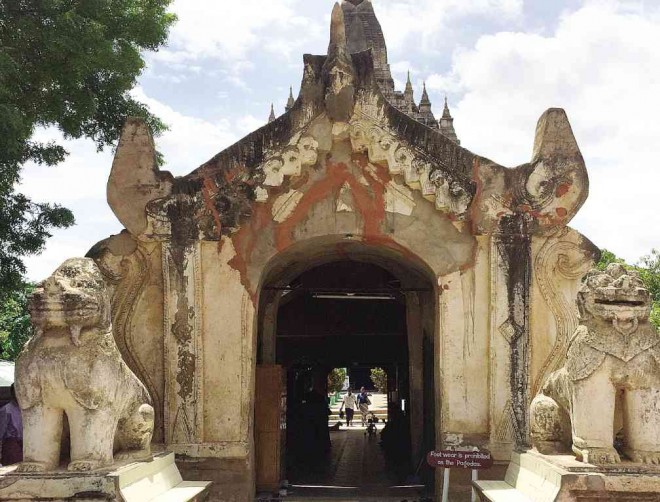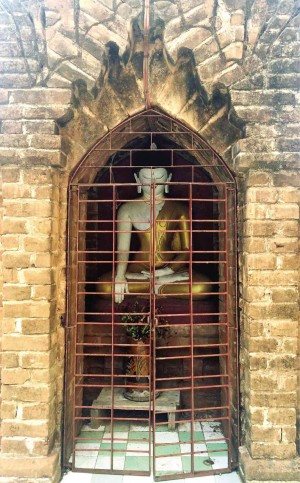
It’s true, Bagan is one of the places you have to go to before you die. It is so special it is a place like no other.
The easiest way to reach this jewel from Manila is via Bangkok, then you can fly either to Yangon or Mandalay. From either of these two cities of Myanmar, you can reach the small town of Bagan via small plane.
The romantic way is by a slow boat that meanders by the wide, mighty river Irrawaddy, from where one can see Burmese life in quiet rural settlements by the riverbanks.
Life in Bagan starts and ends in this river.
Ancient land
From the bustle of Bangkok and Yangon, my travel mate and I land by propeller plane, with Europeans of all ages, on a dry, flatland looking almost forsaken.

Ugly croaking blackbirds abound, stealing glances at passersby from palmy perches or from boughs of evergreen trees lining some of the newly asphalted streets.
One must be prepared to sweat, or be shrouded with boiling dust if one explores on a bike, or clip-clop the dusty streets on a horse-drawn carriage. Occasionally, convoys of army trucks barrel through with blaring sirens. Somehow, one gets scared and wonders what the generals are up to.
Our taxi driver warns us to watch out for rattlesnakes if we venture out. Safely, we arrive in our quaint hotel at dusk.
Watched by a new moon riding high atop clumps of frangipani, we settle on a Burmese dinner of soup of herbed fish, and a viand of chicken, redolent with herbs and curry; rather exotic to my Ilocano palate used to pinakbet.
We linger long on a thickly cushioned sofa, while candlelights in nooks and crannies cast shadows in a sitting area with the scent of the tropics.
We agree to hire a horse-drawn carriage the following morning for us to explore this unfamiliar land. We would have wanted to see the entire panorama on a balloon but August is a precarious month because of the monsoon.
Pensive in this setting, I think about Aung San Suu Kyi, the lady, delicate with her gentle smile, always with a spray of flowers in her hair. She who represents all that is decent in mankind, bearing her imprisonment in her house by the lake with quiet fortitude, fighting for freedom for her beloved Burma!
We want to know more about the country she loves so dearly.
Incredible vista
The next morning, dressed in our longyi (like a sarong) with a genial Burmese who fetches us in a horse-drawn carriage, we start our journey to a land of incredible vista.
If that weren’t enough, then comes a pagoda in glimmering white with intricate embellishments and tall with its pointed dome reaching out to the bluest of skies. And then, more stupas of various sizes and shapes, more pagodas in the fields and small villages in various shades of ancient bricks, and then more of them beside clumps of agave, cacti or flaming bougainvilleas.
Many are in the yards of modest homes, stupas near pigpens and chicken coops, they are everywhere, almost 3,000 of them.
The voyage, especially in a carriage, is one of an unending delight.
A gentle breeze caresses. We rest under the canopy of a rare bamboo clump and move on to the cool majestic corridors of the pagodas. In all of these holy places, there are countless Buddhas; the delicate position of their hands indicates an ancient, unspoken language of purity and hope and redemption.
The images of Buddhas are everywhere in many sizes, some reclining, most in elegant sitting repose. In the walls, in crevices, in every corner, the Buddhas watch.
The Burmese offer flowers: bouquets of marigold; bundles of white lotus; garlands of fragrant white and pale orange camias with rice delicacies and betel nuts. Incense glimmers in the half light, whiffs of burning exotic wood pierce the damp halls of ancient pagodas.
A chant may break the silence. In every doorway, Burmese men and women bearing coconuts or sweets, or figurines of pagodas and Buddhas and bells, insist!
We buy wind chimes that represent the days of the week from a smiling peddler who catches up with us on his bike as our horse-drawn carriage brings us to more pagodas in old Bagan.
I get fascinated with the numerous doors of Bagan. They are elegant in their recurrent curves, hypnotic in their intricacies. My Italian friend goes from door to door documenting them. They celebrate the genius of bygone days and must be remembered.
Exhausted by the August heat at midday, we retreat to a restaurant overlooking the river busy with cargos traveling to and fro. The blackbirds attack the table of two European women travelers for morsels of food and my light nap is pierced by their frightened shouts.
I take a bite of crusted Burmese bread and my Italian friend tries the Burmese beer. The horse is fed with its ration of grass. I rub my face with thanaka, a cosmetic, equivalent of a sunblock, coming from wood scrapings moistened and painted on the face. Worn by Burmese men and women, it is cool to the face.
The ultimate high of a visit to Bagan is to climb the steep steps of one of the towering pagodas and watch the sun set over old Bagan. In this perch, the view becomes even more stunning.
As one goes around the ramparts, one is rewarded by an unobstructed view of all the 3,000 stupas and pagodas all around, each one suspended in a timeless tableau as old as the ages. The river glistens in the fading sunlight and the reddish glimmer of the stupas is slowly subdued by the setting sun.
This spectacle fading into the shadows, as dusk envelopes these vast plains, makes Bagan a truly special place in this earth.
We chill in the pool the following day. I read a book, “Hadrian,” a gift of my friend. In the evening we seek a restaurant by the river.
The meal is accompanied by a famous puppet show followed by the faint throb of a lute. We stroll under two acacia trees whose branches reach out far into the gardens by the banks of the river and rows of empty tables desolate under a late evening shower.
Mount Popa
We wake up early the following day to visit Mount Popa, home of the spirit gods of Burma, much like Mount Olympus, the home of the Greek gods of lore. The excursion takes an hour and a half, passing by rice fields and clumps of tamarind trees.
We visit a schoolhouse, a roadside home brewery of palm wine and then we ascend a zigzag to a cool mountain, suddenly rising abruptly in the plain.
Mount Popa is the abode of the Burmese spirit gods known as Nats. We are introduced to the Nats by a learned guide who is a retired English teacher in old Rangoon. We are told that every Burmese must ascend the 777 steps to the pagoda on top to pay homage to their spirit god.
The Nats are a curious array of deities, each one with a curious story, much like the playful gods of Mount Olympus. Each Burmese has his own assigned Nat to whom he prays for grace.
Barefoot, among the innumerable monkeys who also call Mount Popa their home, we trek slowly up the endless steps, panting and resting to catch a breath and to take in the mountain view.
The climb is a challenge to me, physically and psychologically, and I plod on bravely.
Finally, at the end of the steps, one is rewarded by an unending vista of hills and mountains thick with endless green. The cool air invigorates as the spectacle of nature is laid out into the horizon yonder.
I strike the gong fronting the prayer area three times and the sonorous boom breaks the thin air in the sky. I feel young again with the conquest of Mount Popa.
The monkeys, as we trek down, welcome food thrown their way with cackles of good cheer.
More to see
There is more to see of old Burma. My German friend, who works with Asian Development Bank and who knows Myanmar, speaks of placid lakes, of waterfalls, and villages with gentle people in the mountains and historic towns.
I become nostalgic for the wonderful people of the Cordilleras, keepers of our ancient traditions, guardians of a noble culture still holding on to ways of our highlands that will hopefully be untrammeled by what we of the lowlands call progress.
I recall my early trips to Banaue and Sagada, and I recall the spirit gods to whom our ancestors communed to bring a bountiful harvest, safety of the homes and peace with the land.
It is through travels that one becomes enriched with the bond that shapes our humanity, that rekindles love of one’s homeland. And I know that soon, I will travel again to Burma and other places in Asia.
But before that, I will travel to places in the Philippines that I have not been to and know my country really well for the first time.
The author is one of the country’s top neurologists and until last year, was medical director of St. Luke’s Medical Center. An art collector, he opened and runs the Pinto Art Museum and Gallery.

